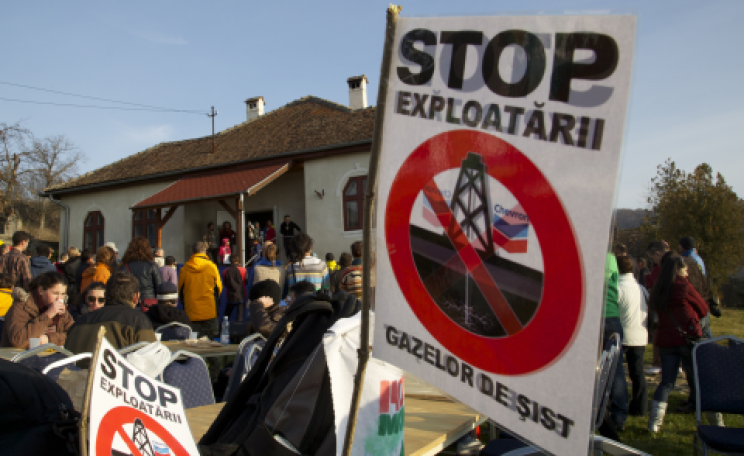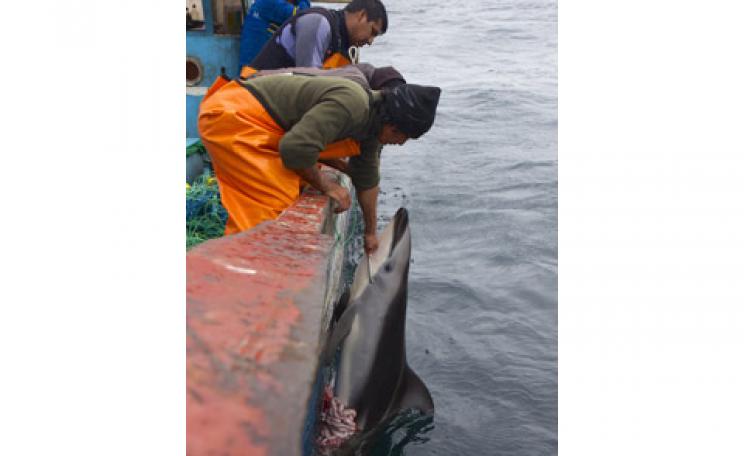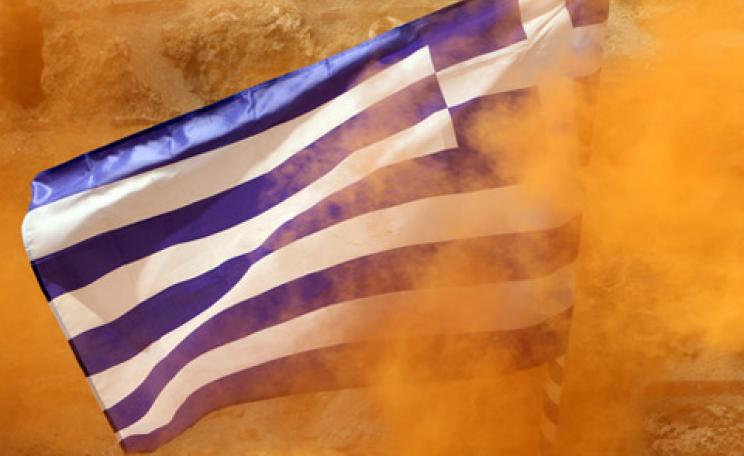It was a like a subway under the house lifting the floor up and down ... We took to sleeping out side on the street.
They are the unlikeliest of eco protestors, a lifetime of hardship engraved on their faces. Wrapped-up in scarves and propped up on walking sticks, dozens have hiked through snow-covered fields to march.
The peasant farmers from the village of Pungesti, a sleepy village on the remote Moldova county on the edge of Romania, are fighting to stop fracking in their village.
The impassioned protests are rapidly becoming a thorn in the side to the Ponta Government - and to the energy companies Ponta has invited in to explore unconventional sources of gas.
View the C4 News report online.
The protests go on
Scenes of riots, heart attacks and police beatings were screened around the world in November, when Chevron first tried to construct the pad for an exploratory tracking well on a muddy field on the edge of Pungesti village.
But winter has set in and the world has moved on. The TV crews are long gone, and the villagers have been left to fend for themselves amidst snow, grinding poverty and the bleak isolation that typifies life in Eastern Romania.
In sub zero temperatures and metre high snow drifts, we returned last week. The protests go on.
We watched as a solemn procession of villagers, flag-waving children and elders propped up on sticks, made the slow, solemn march along the village road, their every move watched by van-loads of police, towering over tiny elderly women tottering on sticks and ushering them along.
Silvica - an improbable Youtube icon
Silvica became a Youtube hit when the first protest clashes occurred in November, filmed as she struggled on hands and knees to wrestle herself out of a line of riot police on the proposed fracking site. We tracked her down.
Several kilometres up a snowy lane, she ushered us into her home, a tiny, dim mud-built house kept cosy by the fire embers glowing in the corner. Over cabbage soup she explained her ongoing resistance to fracking.
"The gas they want from here, we don't agree. We will starve to death ... our flesh will fall off. I've heard about this and we dont want it at all ... If Chevron come they will singe us with gas ... we don't want them."
On the day we filmed, Chevron had sent around a communication leaflet explaining the benefits of fracking. As with many in the village we spoke to, it seems to be too little too late.
Yoghurts and T-shirts
Stories abound of Chevron representatives attempting to hand out yoghurts and T-shirts on the village high street months earlier - crude acts of poorly-calculated PR that backfired spectacularly, with yoghurts thrown back in disgust at the people distributing them.
"It's not nice of the Americans to do such things in this country", says the former mayor Constantin Spiridon, whose land over looks the fracking site.
It was a like a subway under the house lifting the floor up and down ... We took to sleeping out side on the street.
"Here in the yard every local has a cow and they don't need milk from the so-called Chevron representatives ... We don't need T-shirts. Haven't we got things to wear?
In a written reply Chevron claim that they spoke with more than 350 villagers in the village, but "unfortunately Chevron was not able to speak to more residents due to threats from protestors".
Learning from the US experience
Starved of information from sources that are trusted, villagers have been easily turned by internet videos from the USA.
Graphic images of burning water faucets and headline-grabbing studies linking fracking to potential water pollution and farm animal ill-health, have been seized upon.
Perceived threats to resources that have hit the rawest of nerves amongst Romania's rural peasant farmers, 2 million of whom still rely upon clean water, air and soil to sustain their livelihoods. And the hysteria is rapidly reaching fever pitch.
At the protest one woman rages at the police in tears shaking her stick, "the children cry in their sleep ... they are asking, 'are we going to die? are we going to die?''
Earthquakes, poison and beatings
Two hours North lies the crumbling village of Isvoarele, a settlement bordering an oil and gas field in the Moldovan hills.
It has been successfully explored for decades without incident, but in recent months earthquakes and water contamination have made life near impossible for the residents.
We met with one lady who showed us a sinkhole in her living room, and tell-tale cracks in the foundations around her home. 380 earthquakes were recorded in September alone.
"It was a like a subway under the house lifting the floor up and down ... We took to sleeping out side on the street."
According to the mayor of the town, almost half of the water sources in the village are poisonous and there are allegations of physical abuse for those that speak out.
One teenage boy we spoke to was hospitalised for three days last month after he was beaten up - he claims - for speaking out against the earthquakes on an internet video weeks earlier.
Gloopy puddles of leaky oil
At the end of the village, a bleak oil field stretches for as far as the eye can see. Small capped wells whizz around around gloopy puddles of leaking oil.
Despite the natural susceptibility of the region to seismic activity, the mayor admits off camera, that things "may not have been done properly by the energy industry in the past here".
Naturally-ocurring or not, the tales of earthquakes, water pollution and weak environmental controls in Isvoarele perfectly capture the fears of what may happen in Pungesti, if fracking goes ahead.
Solidarity in the cities
Hundreds of miles away in the heart of Bucharest, scene of the Independence struggles against Ceaucescu, several hunger strikers shiver in temperatures of -10 degrees.
Young and angry, and surrounded by signs depicting solidarity for the village of Pungesti, the men sleep in a tent on the street, waving at cars that beep at them from the icy road.
The snowdrifts all around their tents are a stark reminder of the acute importance of policy discussions around energy sources in the coming decades.
Fertile ground for revolution
The Romanian Prime Minister Victor Ponta laid clear his plans for fracking in June of last year.
"Do we want to have gas - first of all to stop importing from Russia? Do we want to make the Romanian industry competitive and, of course, to have lower expenses for the people? Then we must have gas!"
But like the Rosia Montana gold mine protests that preceded it, the anti-fracking movement in Romania has found fertile ground beyond the affected villages, amidst a nationalist rhetoric against corruption and perceived struggles against foreign invaders.
No benefit to communities
Valentina Ivan is an energy specialist focusing on shale development on behalf of foreign investors who eye Romaniaa's shale supplies with excitement.
She believes that a key component in the growing distrust of shale lies in both a failure to properly communicate with rural communities, and a failure to adequately put into place royalty plans that can benefit them.
Under Romania's outdated Petroleum laws, all royalties from the development of shale in Romania must at present go back to the central state.
The communities, she admits with dismay, simply have "take one for the team". Hardly the kind of language destined to win over some of the poorest rural communities in The European union.
'These risks can be controlled'
Alexandru Patruni was the head of the National Agency for Mineral Resources until 2012 and was effectively the man who signed open the way for fracking exploration in Romania.
"Of course there is a risk. but all these risks can be controlled so that the impact can be minimal", he says.
"The direct income that the locals can obtain is the income generated from the lease or sale of the land to the companies that are prospecting ... the land in Romania is private property and their owners can sell them or use them the way that they wish."
In Pungesti that man is Mircia Vlasa, the current mayor of the village, who lays claim to the potentially valuable land where Chevron are constructing their site.
Villagers infuriated
Contacted several times, he refused an interview, but we have seen documents which suggest that the land was improperly obtained by him in 2005.
For the avoidance of doubt: there is no suggestion that the alleged wrongdoing concerning the way in which he obtained the land where the frack site is being built, was in any way connected to the subsequent discovery of shale, nor to the current agreement with Chevron.
But it has infuriated the villagers here. As the protest procession passes the mayor's house, the police carefully line the fences, filming on video cameras as a hundred of his neighbours scream obscenities over the fence.
They feel that the mayor stole the land that has been handed over to Chevron, and that he has failed to help them to resist the energy company's exploratory moves into Pungesti.
They take it as a personal betrayal that has bitterly stoked the pressure cooker politics of this remote village which finds itself at war with Bucharest, and the energy company that has been invited into their village without their consent.
A dozen police vans stand guard
400 metres from the frack site, a dozen police vans, a military-grade riot vehicle and even a fire truck lie behind a police cordon, protecting the concrete pad from the wrath of a hundred elderly villagers and some children waving flags.
Everyone in the village knows the drill by know and few attempt to cross the line of police who are there to prevent the procession from getting close to the frack site.
After a Chevron brochure is held up and lit alight to cheers, the villagers trudge back to their homes in the dying light of day through long paths of deep snow.
Maria is an exception. Carrying long slender candles under her arm. she elbows her way past the long line of police in the direction of a religious shrine that has been built just yards from the wire fencing of the frack site.
A newly-erected wooden crucifix depicts Christ on the cross above a mound of earth underneath which lie a skull and cross bones. Blending environmental imagery with religious iconography, the message is clear. Religious fervour and passion surrounds the debate about fracking in Pungesti and in Romania today.
Free us of the calamity ...
Under the watchful eye of the police, the elderly lady light the candles on her knees, cradling the flicking flames in the icy wind as they pray under their breath to Saint Paraschiva the protector of Moldova County.
"Don't abandon us, protect us and free us of the calamity that they brought upon us here", she whispers. Metres away on the other side of the fence, the frack pad construction continues. For now.
View the Channel 4 News report of 18th February 2014: The Peasant's revolt - Fracking fault lines reveal a country at war with itself.
Jim Wickens is an investigative journalist. He works for the Ecologist Film Unit and is a regular correspondent for The Ecologist.
Paraic O'Brien is a reporter for Channel 4 News.







